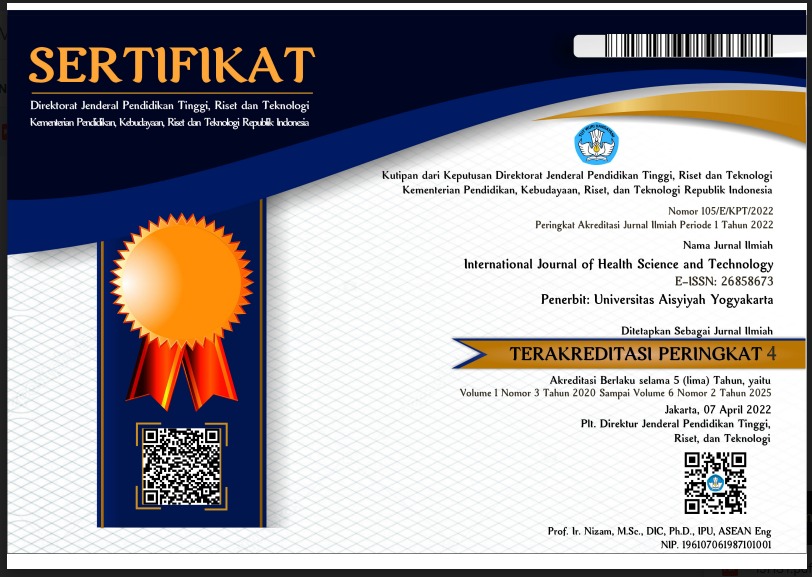The correlation between the quality of anc services and the incident of lbw In the public health center of Wates in Kulon Progo Regency
DOI:
https://doi.org/10.31101/ijhst.v1i1.948Abstract views 1165 times
Keywords:
The Service Quality of AN, , Antenatal, LBWAbstract
References
Alam Mahumud, Rashidul et.al. 2017. Distribution and Determinants of Low Birth Weight inDeveloping Countries. Journal of Preventive Medicine & Public Health
Arunda, Malachi, et, al., (2017). Effectiveness of antenatal care services in reducing neonatal mortality in Kenya: analysis of national survey data. Global Health Action. Tailor and francis
Cetia Regina, et.al. 2014. Adequacy of antenatal care and its relationship with low birth weight in Botucatu, São Paulo, Brazil: a case-control study. Pregnancy and Childbirth. BMC Dinas Kesehatan DIY. 2016
Fonseca. C.R.B, et.al. 2014. Adequacy of Antenatal care and its Relationship with low birt weight in Botucatu, Sao Paulo, Brazil: a case control study. BMC. Pregnancy & Childbirth
Kemenkes, RI. 2016. Profil Kesehatan Indonesia. Jakarta
Manuaba, Ida Ayu Chandra, et al. 2010. Ilmu Kebidanan, Penyakit Kandungan dan KB Untuk Pendidikan Bidan. Penerbit, EGC. Jakarta
Prawirohardjo, Sarwono. 2010. Ilmu Kebidanan. Penerbit, Bina Pustaka. Jakarta Profil Kesehatan Kabupaten Kulon Progo. 2017.
Proverawati, Atikah dan Ismawati, Cahyo. 2010. Berat Badan Lahir Rendah. Nuh Medika . Yogyakarta
Ruindungan, Ribka Yulia. 2017. Hubungan pemeriksaan Antenatal care (ANC) dengan kejadian berat badan lahir rendah (BBLR) di wilayah Kerja RSUD Tobelo. EJournal Keperawatan e-Kp Volume 5 Nomor 1, Februari 2017
Sistiarani, C. 2008. Faktor maternal dan kualitas pelayanan antenatal yang beresiko terhadap kejadian berat badan lahir rendah (BBLR) studi pada ibu yang periksa hamil ke tenaga kesehatan dan melahirkan di RSUD Banyumas tahun 2008.Semarang
Unicef. 2017. Data: Monitoring the Situation of Children and Women (Accessed on November 25th, 2017 https://data.unicef.org/topic/nutrition/lowbirthweight/#) University of Rochester Medical Center. 2014, dan Shore. 2009 https://id.scribd.com/document/352894091/
BBLR.
Vishnu Khana, et, al .2014. Role of antenatal care and iron supplementation during pregnancy in preventing low birth weight in Nepal: comparison of national surveys 2006 and 2011. ARCHIVES OF PUBLIC HEALTH WHO. 2014. Global Nutrition Targets 2025 Low Birth Weight Policy Brief. (Diakses pada tanggal 25 November 2017 http://apps.who.int/iris/bitstream/ 10665/ 149020/2/WHO_NMH_NHD_14.5_eng.pdf?ua=1 )
HO. 2015. World Health statistics. (Accessed on Desember 5th, 2017 http://apps.who.int/iris/bitstream/ 10665/170250 /1/9789240694439_eng.pdf) WHO, 2015. Maternal, newborn, child and adolescent health. 2017 (Accessed on Desember 5th, 2017
http://www.who.int/maternal_child_adolescent/newborn /prematurity/en/ )
World Bank, 2015. Data Value. Available: http://data.
worldbank.org/indicato /SP.DYN.LE00.IN?order=wbapi_data_value_2013+wbapi_data_value+wbapi_daa_value-last&sort=asc.
Yaya, Sanni, et.al. 2017. Inadequate Utilization of Prenatal Care Services, Socioeconomic Status, and Educational Attainment Are Associated with Low Birt Weight in Zimbabwe. Frontiers. In Public Health
Downloads
Published
How to Cite
Issue
Section
License
International Journal of Health Science and Technology allows readers to read, download, copy, distribute, print, search, or link to its articles' full texts and allows readers to use them for any other lawful purpose. The journal allows the author(s) to hold the copyright without restrictions. Finally, the journal allows the author(s) to retain publishing rights without restrictions
- Authors are allowed to archive their submitted article in an open access repository
- Authors are allowed to archive the final published article in an open access repository with an acknowledgment of its initial publication in this journal

This work is licensed under a Creative Commons Attribution-ShareAlike 4.0 Generic License.










